Author: Devansh Juneja, CoinBureau
Translator: Glendon, Techub News
If you are seeking cryptocurrency investment opportunities with a high Beta value (high risk, high return) that require practical application support, continuous institutional funding (the Solana ETF application wave), extremely low transaction fees (0.01%), and ecological maturity, then Solana will be an asset worth buying and holding. However, it is essential to cautiously allocate scale and respect key risk levels, considering a long-term allocation of 5-12% and preparing for a pullback of around 15-30%. If this is not your style, you can treat it as a tactical trade—buying on dips of 8-12%, reducing positions when breaking support levels by 10-15%, and taking profits during a 20-30% upward trend.

Before delving into the ecosystem and market indicators of Solana, it is necessary to explain how we arrived at our investment conclusions. This article's discussion framework integrates fundamentals, technology, applications, and risks, allowing readers to clearly understand the criteria behind each rating. However, the assessment weights of all factors are not the same. Fundamental factors are the most important, followed by network attractiveness and technical factors. The specific analysis is as follows:
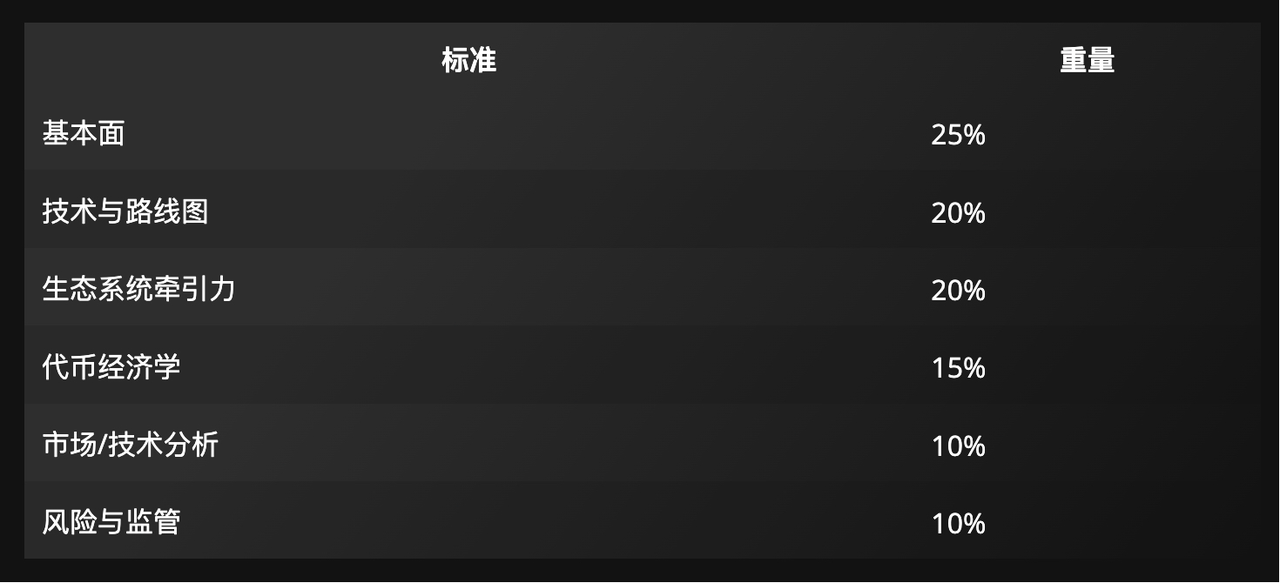
This structure focuses on factors that drive long-term value and protocol strength, helping to enhance its adoption rate while still considering short-term trading signals and regulatory risks.
This article extracts real-time market data from CoinMarketCap and CoinGecko, network performance data from Solscan and Validator.App, and downtime/uptime data from Solana Status. Developer activity is tracked through GitHub commits in the core Solana codebase, while the ecosystem's attractiveness comes from dashboards like DeFiLlama and NFT markets like Magic Eden. (Note: Additionally, this report's analysis is conducted independently, with no paid relationship with Solana or its affiliates. Data comes from publicly verifiable sources but should not be considered financial advice. Cryptocurrency investments remain highly volatile, and readers should conduct their own due diligence before taking action.)
What is Solana?
First, let's quickly understand Solana, whose design goal is simple: to achieve high throughput without reducing costs. The chain combines Proof of History (PoH) and Proof of Stake (PoS), with the former providing a shared clock for each validator and the latter ensuring finality. Additionally, PoH reduces the dialogue required for transaction ordering, while PoS secures the ledger. In practice, this allows Solana to confirm blocks within sub-second time slots and keep the fees for most operations close to zero.
Solana was founded in 2017 by Anatoly Yakovenko (a former Qualcomm employee), with early contributions from Greg Fitzgerald, Raj Gokal, and others. Their idea stemmed from a problem Yakovenko discovered in distributed systems: reaching consensus on transaction order (time) increases overhead and latency. The solution they proposed was Proof of History: a cryptographic clock built using verifiable delay functions, allowing transactions to be timestamped in a timely manner without requiring validator consensus for each ordering. The design goals are:
Achieve low latency (fast block/slot times, minimal delay);
High throughput (parallel execution under load);
Low transaction fees, enabling smooth use even for small transfers. The PoH + PoS mixed consensus mechanism, along with optimizations like Tower BFT, Turbine (block propagation), and Sealevel (parallel execution), accomplish these goals.
In 2020, Solana's mainnet Beta version was launched, with early indicators from its testnet showing the ability to complete over 50,000 transactions per second in a controlled testing environment using GPU-supported nodes.
Core Components
Validator Clients and Client Diversity
The original Solana Labs client (now Agave under Anza) remains its foundation. Most validators run on Agave or its forks. Jito-Solana is a fork of Agave that adds MEV (Miner Extractable Value) infrastructure, gaining a significant share of staking by providing additional reward opportunities for validators and delegators.
Currently, Firedancer (Jump Crypto) is under active development. Its goal is to become a high-performance C/C++ client with a modular design, expected to achieve extremely high TPS upon full deployment. Its predecessor "Frankendancer" combines components from Firedancer and Agave and is currently running in a mixed mode on the testnet and early mainnet.
PoH + PoS + Support Systems
Proof of History (PoH) is core. A verifiable delay function based on SHA-256 creates a hash chain (tick count) that becomes part of the ledger, allowing all validators to reach consensus on ordering without repeated messaging between validators. Combined with Tower BFT (Solana's PoS consensus layer), this allows the chain to avoid common latency penalties found in other distributed consensus protocols.
Sealevel runtime supports parallel execution: smart contracts (programs) can run on non-intersecting accounts and state sets, allowing many transactions to be processed simultaneously across different cores/nodes. This contrasts with the sequential execution of many other blockchains.
Fee Model and MEV Integration
The base fee for each signature is extremely low; when the network is congested, users/DApps can add priority fees to continue operating. The computation budget plan allows developers to specify computation limits and prices, enhancing predictability.
MEV (Miner/Validator Extractable Value) infrastructure has been expanded. Clients like Jito-Solana have introduced block engine functionality and bundle auctions, sharing MEV rewards with stakers. These features encourage validator client forks (new clients) to incorporate MEV logic, which will impact network economics and fairness.
Technology and 2025 Roadmap Practical Testing
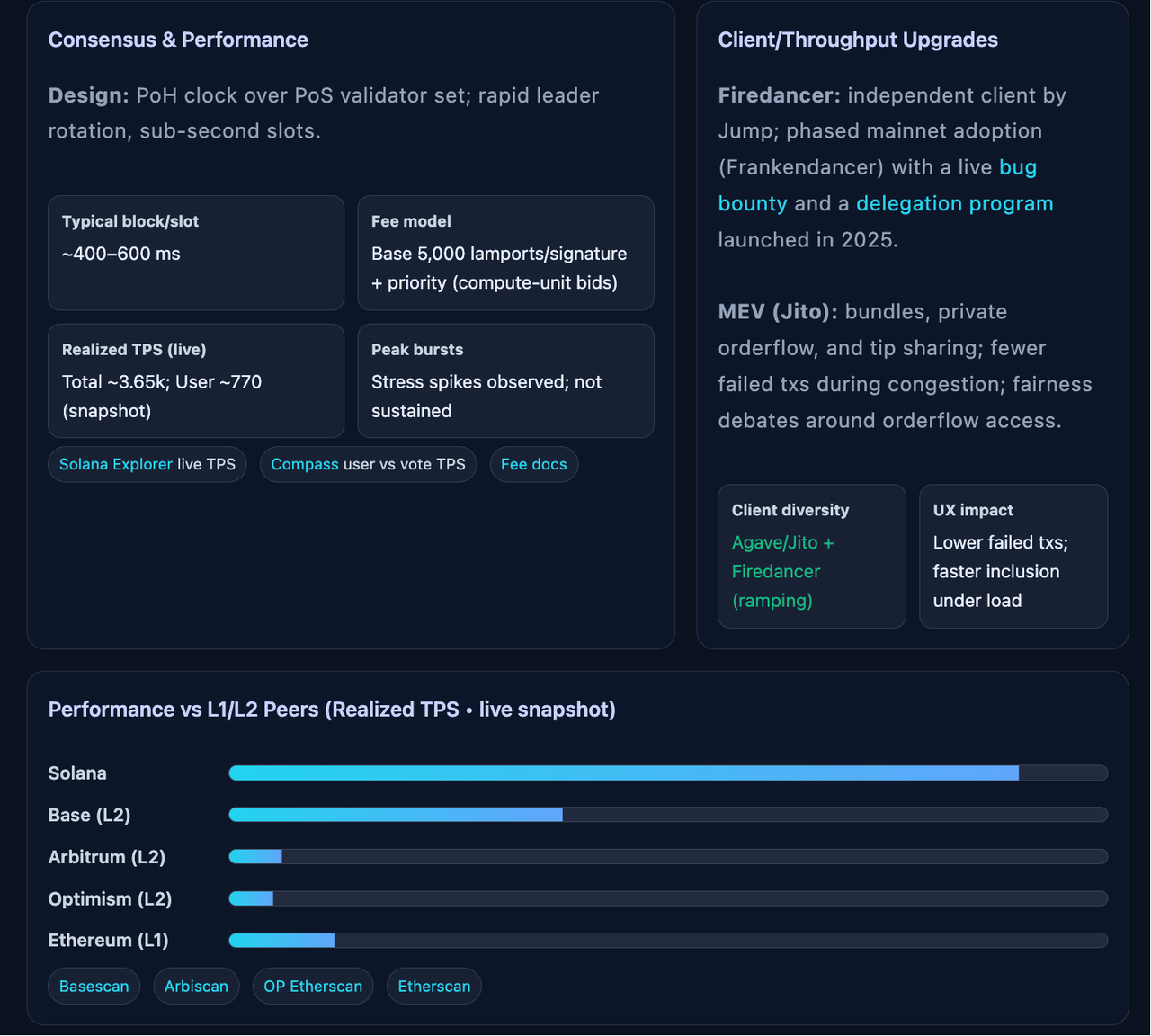
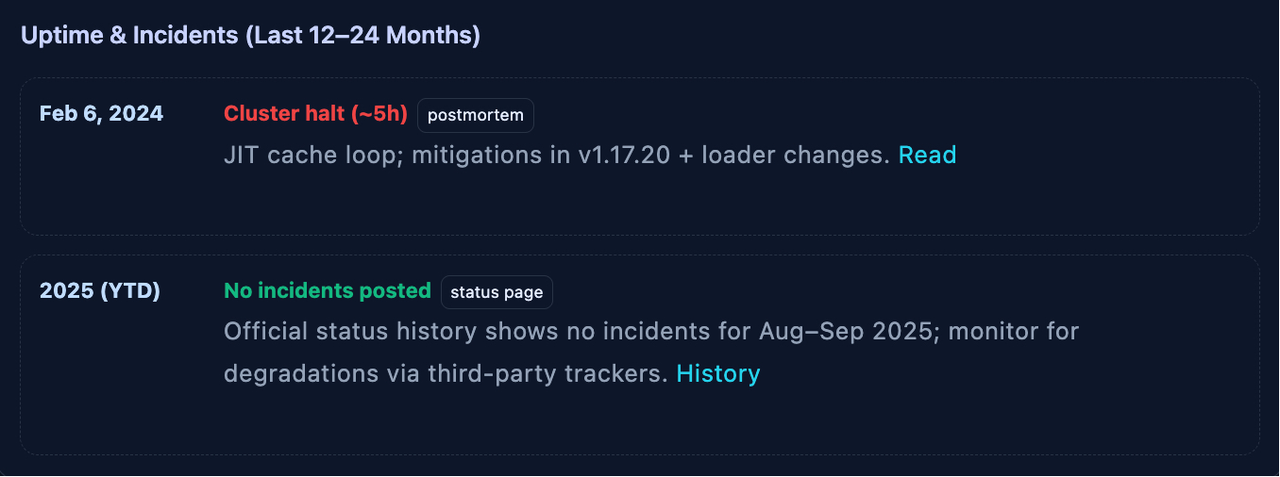
As of September 20, Solana's TPS totals approximately 3.65k TPS, with the current median fee around $0.0016; the last complete halt of event logs was on February 6, 2024 (v1.17.20 fix). The official status history (status.solana.com) shows that Solana has not released any event status pages in 2025 (from the beginning of the year to now), and no incidents occurred between August and September 2025; performance degradation can be monitored through third-party trackers. Data source: Explorer, Compass.
Tokenomics and Staking Economics
Solana's tokenomics model is designed to incentivize staking, gradually reduce inflation, and ensure the utility of each SOL through transaction fees, rent, and collateral.
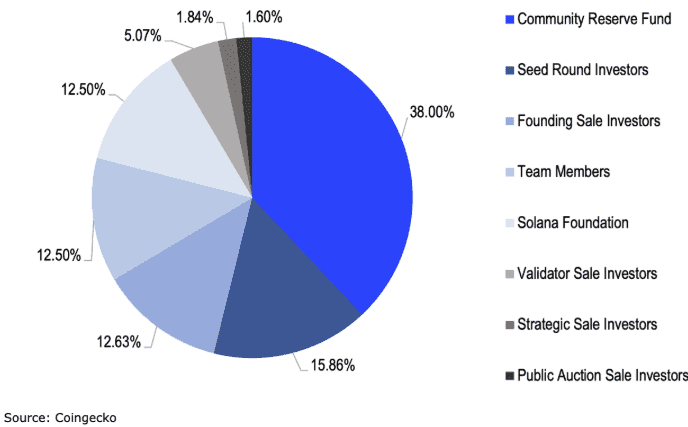
Solana's tokenomics emphasizes supply dynamics and inflation control
Supply Mechanism
Here is the situation as of mid-2025:
Total supply: approximately 610 million SOL;
Circulating supply: approximately 543 million SOL (about 89% of total);
Non-circulating supply: approximately 67 million SOL (about 11%), typically related to ecosystem or locked allocations;
Staked share: approximately 411 million SOL (about 67.4% of circulating supply), indicating strong staking participation;
Locked staking: approximately 25.9 million SOL (about 6.3% of staked), which cannot be withdrawn until the lock period expires.
The inflation model adopted by Solana starts with an issuance rate close to 8% in the first year, then decreases by 15% each year until a final rate of about 1.5%. Half of all base transaction fees will be burned, creating slight deflationary pressure as transaction activity expands.
In terms of fee design, each transaction incurs a small base fee (5,000 lamports per signature). Currently, 50% of this base fee is burned, and the other 50% is allocated to the leader. Priority fees are optional tips set for each computation unit; since the SIMD-0096 change, validators receive 100% of the priority fees (previously it was a 50/50 burn/split).
The circulating supply will fluctuate with issuance, staking amounts, and fee burns, so please refer to real-time trackers: Solana Compass continuously updates data on circulating/total supply and inflation status.
The significant implication is that over time, reducing the inflation rate + fee burns can offset dilution, while priority fee routing can adjust validator incentives and reduce off-chain transactions during congestion.
Investor Staking
Native staking on Solana typically yields mid-single-digit annualized returns, compounded each cycle. Redeeming staked assets requires a cooling-off period, which occurs at the boundary of each cycle (approximately 2-3 days), after which SOL can be withdrawn; depending on network-wide limits, the warm-up/cooling period may last multiple cycles.
Liquid staking options (such as Marinade's mSOL and JitoSOL) eliminate the cooling-off period while maintaining fund liquidity by delegating across multiple validators; both projects have published their current annualized returns and methods.
About the Penalty Mechanism: Solana's documentation emphasizes redemption delays and validator performance; current foundation materials indicate that there will be no penalties on the principal for typical misconduct on the mainnet, so the primary risk for investors is missing out on earnings from poor validators rather than losing staked assets.
Demand Drivers for SOL
SOL serves as the foundational unit for the following actions:
Paying base fees and priority fees for each transaction
Maintaining rent-free reserves for creating/holding on-chain accounts
Staking to ensure consensus and earn rewards
Pricing scarce block space under load through priority fees and computation budget programs
These mechanisms link activities in DeFi, NFTs, and payments to the demand for SOL through fees and staking.
Solana Staking Yields and Inflation Rates
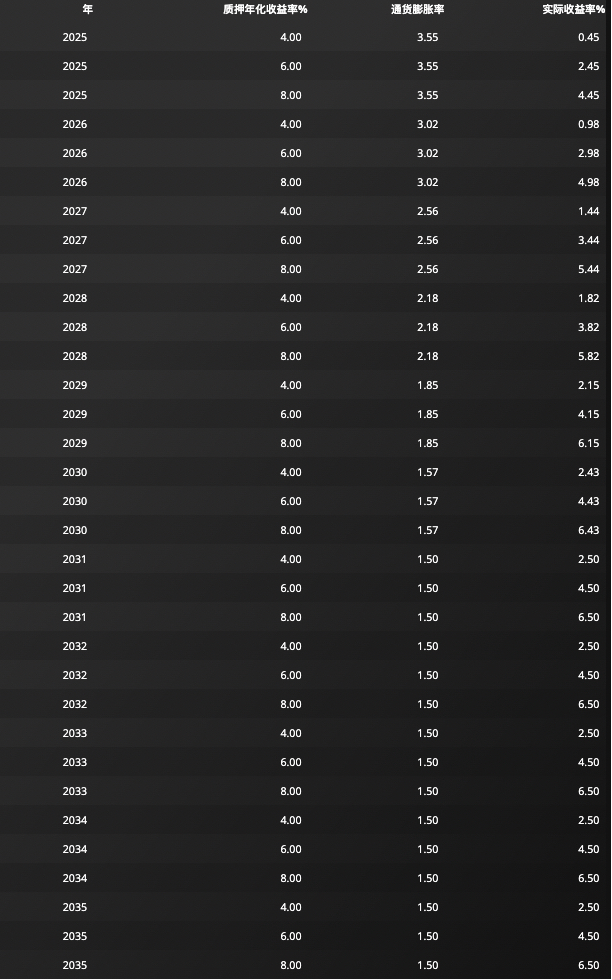
Solana Supply Curve
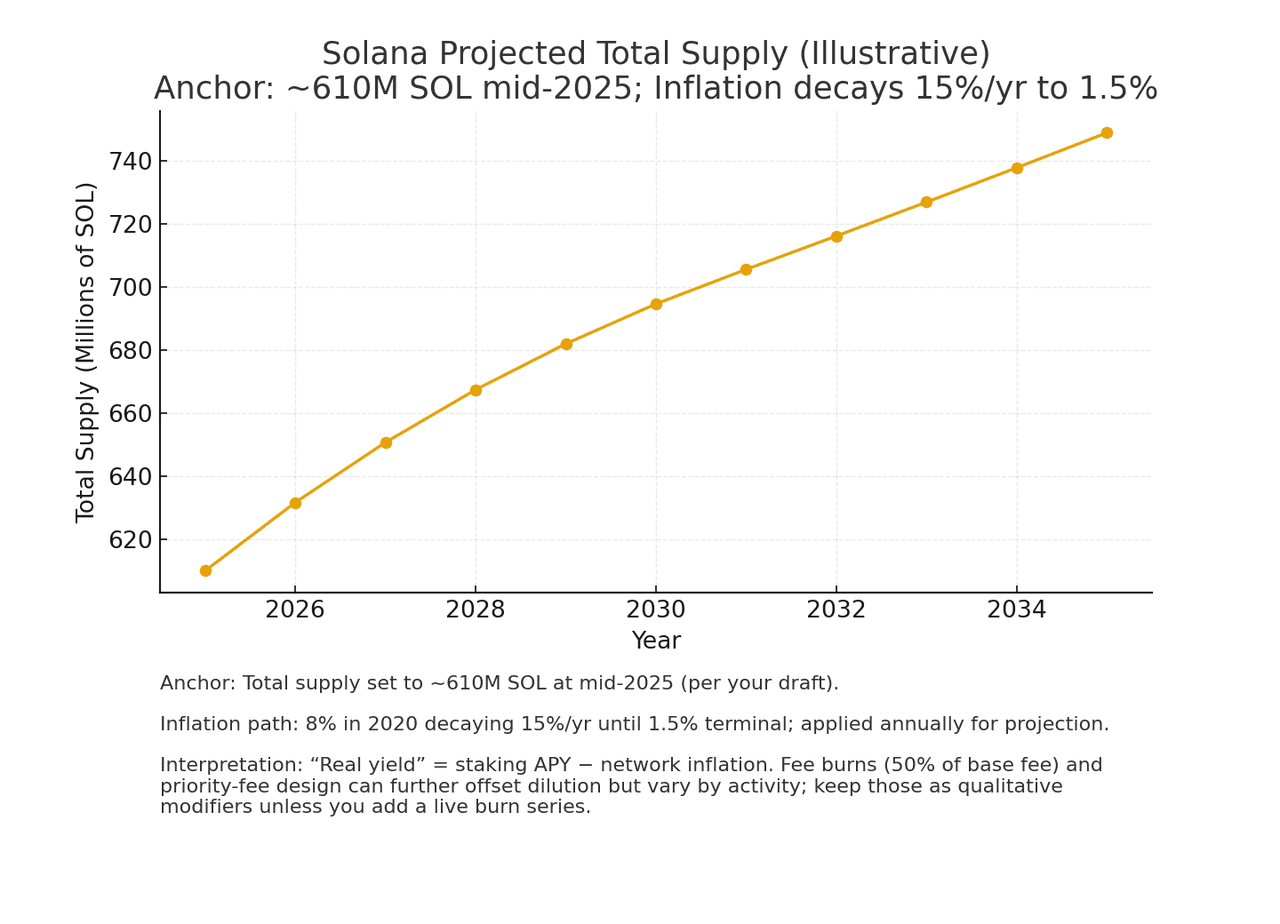
Ecosystem Traction: Where Does Demand Come From
The demand for the Solana ecosystem is primarily reflected in the total value locked (TVL) in DeFi, NFT trading volumes, and the growing enterprise/payment integrations.
DeFi
According to data from DeFiLlama, as of September 2025, Solana's DeFi TVL stands at $12.49 billion.
Top protocols by TVL:
Jupiter TVL approximately $3.65 billion
Jito TVL approximately $3.61 billion
Kamino TVL approximately $3.46 billion
Sanctum TVL approximately $3.23 billion
Raydium TVL approximately $2.6 billion
Stablecoins on Solana (especially USDC) are crucial in liquidity pools and lending protocols. A significant portion of the locked value comes from stablecoin-denominated assets, which reduces volatility for users of these protocols. DeFi is a pillar of SOL demand. Growth in TVL indicates real, repeat usage rather than mere speculation. Protocols combining staking, liquidity, lending, and aggregation are attracting capital and retaining users.
NFT and Consumer Applications
Consumer applications and DApps are leveraging this momentum: wallet tools like Phantom (in-wallet swaps), simplified NFT launchers (via Magic Eden), and Web3 games are increasing user numbers. Faster minting and lower transaction costs enable small creators to easily participate.
This indicates that NFTs and consumer-facing applications are broadening the demand for Solana, bringing in not only significant funds from the DeFi space but also many everyday users engaging in token drops, trading, and minting. This generates more organic demand for SOL through transaction fees and gas usage.
Payments/Enterprise
Solana Pay has made progress: Shopify merchants can accept USDC through Solana, enjoying low fees and faster settlement speeds. This indicates that enterprises are interested in using Solana not only for DeFi or NFTs but also for its practical applications in business.
Due to Solana's finality and low transaction costs, stablecoin settlement channels (via Circle's USDC) are becoming increasingly popular for cross-border transfer use cases. Companies trialing fiat deposit and withdrawal channels in certain regions are also testing Solana's capabilities as a backend channel. (Although data in this area is limited, enterprise use cases are growing.)
The significance lies in the fact that payment and enterprise integrations bring sustained demand and transaction volume, helping SOL's value transcend speculative or purely crypto-native uses. Growth in this area contributes to stabilizing network usage and demand for SOL through settlement, access, and trading.
Summary
The demand for Solana comes from three mutually reinforcing pillars:
DeFi (deep liquidity, trusted protocols)
NFT/daily user applications (large numbers of small-batch users)
Enterprises and payments (merchant onboarding, real-world usage)
These activity levels generate both transaction and gas demand, as well as token demand (staking, fees, priority fees), which constitute the structural drivers of SOL's value. Given the current growth trend, this demand appears sustainable into 2025.
Market Performance and Price History
Solana's market trajectory has experienced extreme cycles, massive rallies, deep crashes, and rapid recoveries. Each phase reflects the macroeconomic impacts on cryptocurrency and Solana-specific catalysts.
Significant Declines and Recovery Cycles
Crypto Winter (November 2021 - December 2022): Down 95%
SOL fell from a historical high of about $260 in November 2021 to an intraday low of about $8 on December 29, 2022 (closing price around $9.6). The collapse of FTX/Alameda exacerbated SOL's decline, and network outages in 2022 also weakened market confidence. These events collectively led to the excessive sell-off of this blue-chip project.
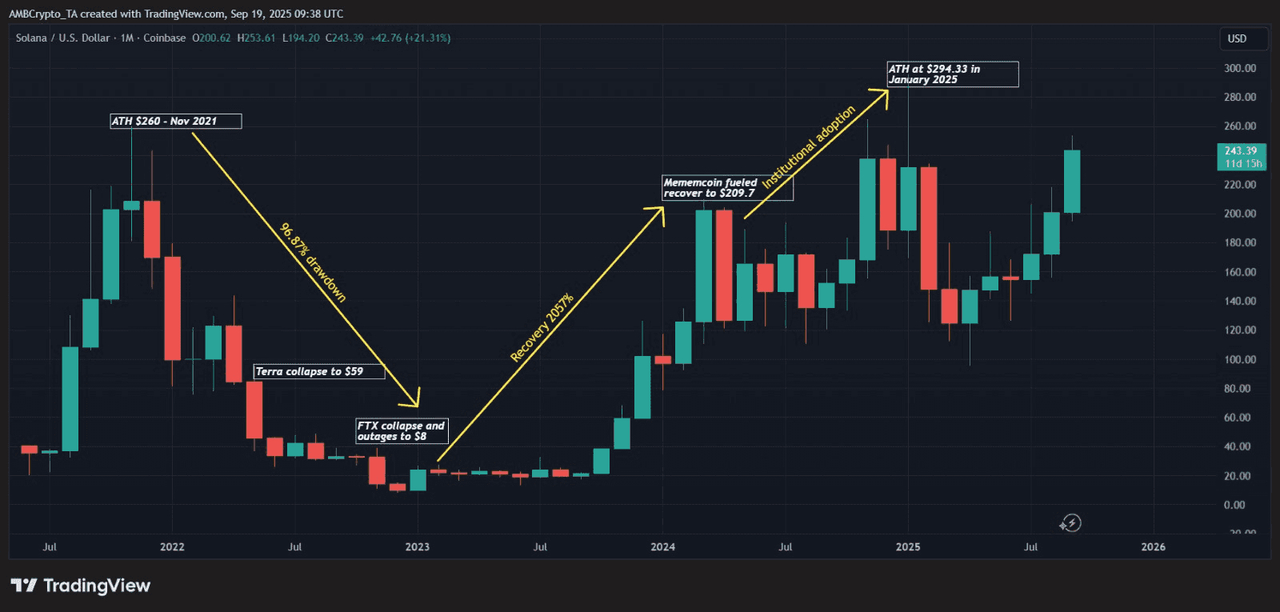
Terra Luna Contagion (May 2022): Down 40%
During the Terra collapse (from May 7 to May 12, 2022), SOL dropped from about $79 to an intraday low of about $36 (closing around $45 on May 12), then rebounded to about $59 on May 15, indicating that L1 tokens are relatively susceptible to systemic DeFi shocks.
Memecoin-Driven Recovery (2023-2024): Surge of 3000%
Solana rebounded over 3000% from a low of nearly $8 in December 2022, reaching a historical high of $294 in January 2025. The driving forces included the BONK memecoin airdrop, the popularity of the Saga phone, the launch of PYUSD on Solana in May 2024, and the increasing number of Solana ETF applications in 2024-2025.
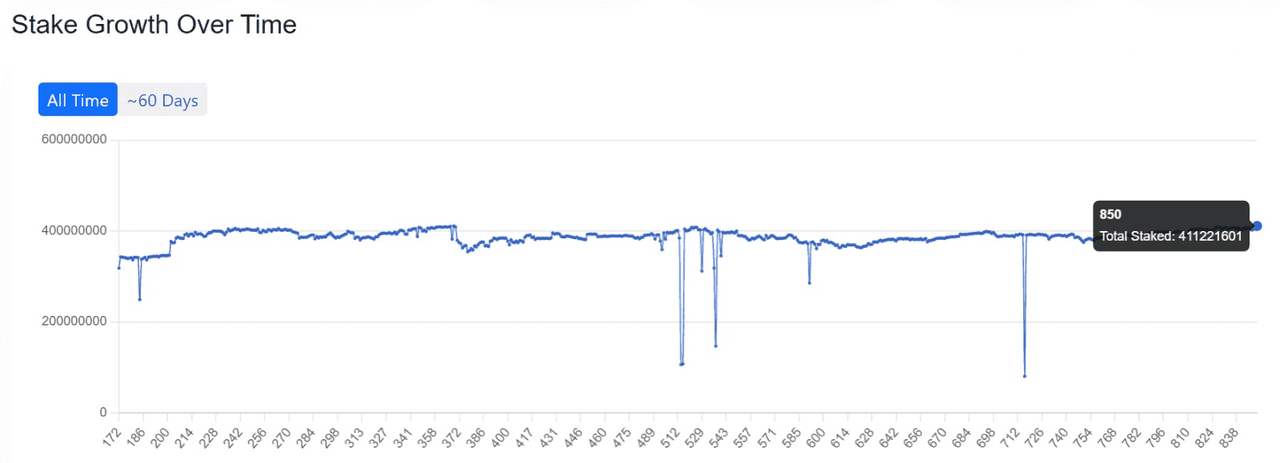
Current Cycle (2025): Testing Historical Highs
As of September 2025, SOL's trading price is around $244-250, close to its historical high of about $294 in January. Approximately 70% of the supply has been staked, leaving about 85 million circulating tokens. The locked circulating supply, combined with the growing institutional holdings, Solana bonds, and ETF applications/updates from Invesco, VanEck, Bitwise, Grayscale, Franklin Templeton, Fidelity, 21 Shares, and CoinShares, supports this rise.
Quarterly Summary (2025)
Q1 2025 - Ecosystem Prosperity
On-chain GDP grew by 20% quarter-over-quarter, reaching $1.2 billion, stablecoin supply surged by 145% to $12.5 billion, and DEX trading volume averaged $4.6 billion daily, peaking at $36 billion in a single day.

Q2 2025 - Redistribution and Volatility
As dormant wallets were reactivated, this spurred a surge in Coin Days Destroyed (CDD) and triggered a wave of profit-taking. After each surge, SOL stabilized within a narrower range, indicating an accumulation phase before the next rally. (Note from Techub News: Coin Days Destroyed (CDD) is an indicator measuring the intensity of economic activity in the cryptocurrency market by calculating the amount of coin days destroyed when long-untraded crypto assets are consumed to assess market dynamics.)
Solana Associated Dynamics

Comparison of one-year performance of BTC, ETH, and SOL shows divergence
BTC/ETH: Correlation of 0.57, indicating macro forces causing them to move in tandem.
BTC/SOL: Correlation of 0.40, reflecting Solana's independence through network catalysts (e.g., memecoin rebounds, upgrades).
ETH/SOL: Correlation of 0.76, driven by overlapping DeFi demand.
For most of 2025, BTC and ETH's movements were nearly synchronized (with correlations reaching 96-100%). Solana experienced significant divergence in February, decoupling from BTC and rising 80%, while BTC/ETH's gains were more moderate, indicating that unique catalysts created tactical windows for SOL's positioning.
Solana Technical Analysis
Solana is currently at a critical juncture. Price action shows consolidation below resistance levels, with support levels being tested. Momentum indicators are mixed; some suggest a rebound risk, while others indicate further declines if key levels are lost.
Trends and Momentum
From October 2024 to mid-April 2025, Solana fell into a firm downtrend, with the 20-day simple moving average (SMA) positioned below the 50-day and 200-day moving averages. The MACD indicator repeatedly showed bearish crossovers, and the histogram remained below zero, confirming Solana's weakness.
In mid-April, the 20-day SMA climbed above the 50-day SMA, marking a reversal. At the beginning of May, the SMA golden cross broke above the 200-day moving average, driving a strong rebound. By the end of May and in July, buyers held the 50-day moving average, while the MACD bullish crossover and expanding histogram confirmed strong momentum. As September approached, the gap between the SMAs continued to widen, indicating that the uptrend remained intact, with prices consolidating around $240-250.
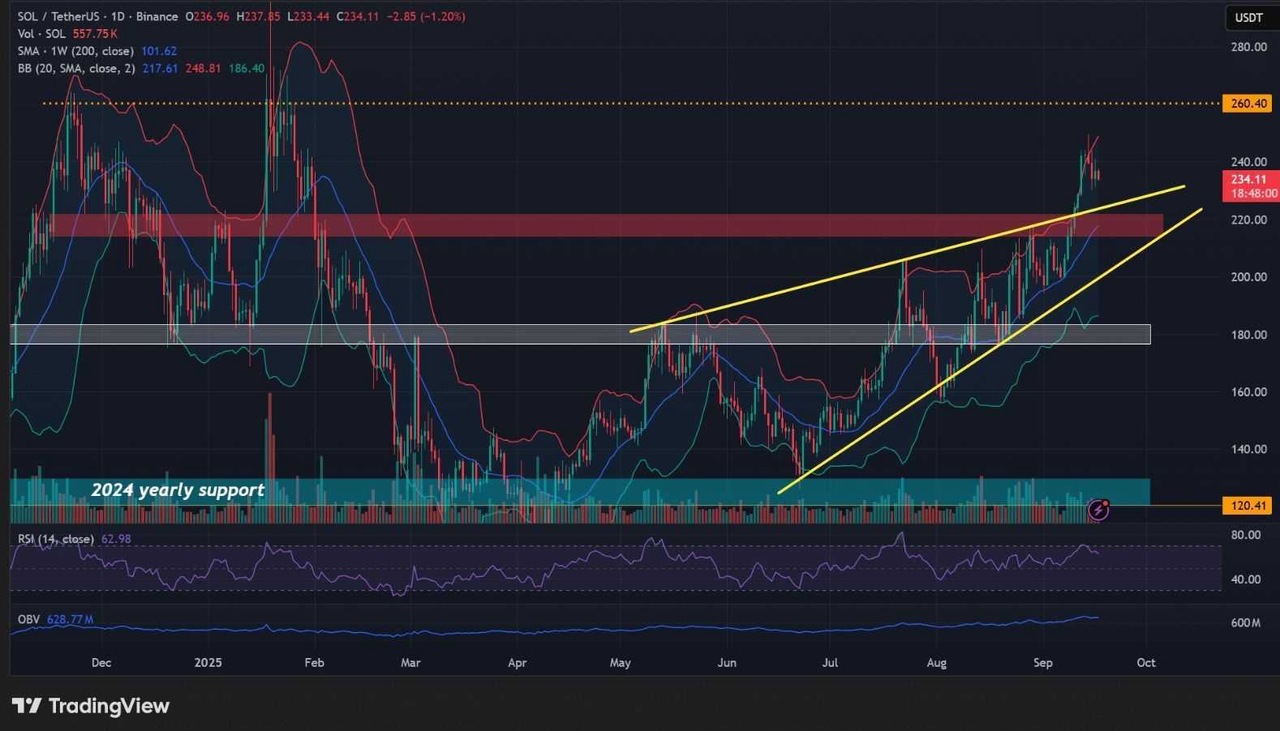
Key Support and Resistance Levels
Momentum provides directional guidance, but key levels indicate the market's actual stance. Solana's key support level is around $200-205, which has been tested multiple times since July. Resistance is forming around $260-265, with the historical high of $293.31 set in January 2025 being the main resistance level. The area with the highest trading volume is concentrated around $230, forming a strong demand zone. If SOL decisively breaks above $265, it could open the door to record new highs, while a drop below $200 could see it retreat to the $180 range.
Volatility and Liquidity
Price levels alone do not tell the whole story. To understand the sustainability of these trends, liquidity and derivatives activity also play a role. In the past week, open interest rose alongside prices, but did not trigger a peak in liquidations, indicating that the increase in leverage is steady rather than purely impulsive. The funding rates hovered just above zero, reflecting a bullish inclination rather than a bubble.
As the week approached its close, open interest stabilized, and prices consolidated, suggesting that the market is moderately taking profits rather than being forced to liquidate. There was no sudden surge or drop in capital, indicating that traders are responsibly managing risk, with recent volatility driven more by spot demand than leveraged speculation. This healthier pattern reduces the likelihood of sharp reversals and enables the market to sustain trends in the face of ongoing demand.
Expert Price Predictions and Consensus (2025-2030)
By examining short-term and long-term forecasts, one can understand whether the current valuation aligns with institutional beliefs or speculative hype.
SOL Forecast Range and Analysis Rationale for 2025-2027:
Expected to reach $250 to $300 by the end of 2025; if SOL breaks through the resistance level around $193-200; adoption rates and NFT/DeFi will drive demand (prediction from Analytics Insight).
Expected to be around $300 by the end of 2025; belief that institutional capital inflows + ETF speculation can push SOL back to or even beyond its previous all-time high (prediction from The Economic Times).
Range of $255 to $480, with an extended target price of around $555; if ecosystem growth and macro trends are favorable, the price is expected to reach around a hundred points in the baseline scenario; upside potential depends on liquidity and market sentiment (prediction from InvestingHaven).
$186-200 (conservative/base); if regulatory resistance or macroeconomic recession suppresses earnings, technological and network improvements will only be slightly factored into the price (prediction from Brave New Coin).
By 2030, the highest target is $903.78; this bullish expectation leans towards the long term; however, for 2025 to 2027, they expect moderate gains unless significant catalysts emerge (prediction from Cryptonews).
2030 Outlook
Base case: If adoption rates continue to grow steadily, upgrades succeed (Firedancer and client diversity), usage in DeFi, NFTs, and payments scales well, and the regulatory framework is moderate/stable, the average price of SOL could be between $400 and $700.
Bullish scenario: If SOL becomes a major settlement layer and is adopted by institutions, with significant increases in Web3/NFT/gaming usage, the potential upside could exceed $900-1200. Additionally, it depends on favorable macroeconomic factors (e.g., crypto-friendly regulations, liquidity inflows).
Bear market scenario: If many Layer-1 competitors surpass SOL, or if disruption/regulatory pressure intensifies, SOL may struggle to maintain above current resistance levels, potentially trading in the range of $100 to $220 for the long term.
Forecast Quality Notes
Model assumptions: Many predictions assume "ideal" conditions (ETF approvals, clear regulations, macro liquidity, high usage rates). If any of these conditions are not ideal, triggering factors could lead to a chain of negative effects (bearish returns).
Data recency and historical records: Predictions are based on 2025 data, but some institutions released forecasts earlier (2023-24) and may have missed mid-term events (e.g., interest rate hikes, macro shocks).
Wide error margins: There is a significant gap between the lowest and highest predictions—reflecting uncertainties in regulatory frameworks, competition, scalability issues, and network reliability.
Bias risk: Some bullish predictions may rely on hype (meme coins, TVL growth) rather than sustained fundamentals; if adoption is slow, other predictions may be overly conservative.
Solana vs. Ethereum (and L2)
Solana and Ethereum now serve different domains. Ethereum anchors high-value settlements and a large L2 stack. Solana focuses on throughput and user experience within a single L1. A clear comparison requires examining three levers: transaction costs, the activities and revenues they capture, and where builders/liquidity are concentrated.
Throughput and Fees
Key points: Solana's actual user throughput is around 1000 TPS under normal conditions, potentially increasing significantly under stress. Median fees are below a cent. Ethereum Layer 1 is slower and has higher Layer 1 fees, but Layer 2's regular costs can reach around a cent.
Solana fees: Base fee = 5000 lamports (0.000005 SOL) per signature. During congestion, priority (tip) fees dominate. Even during busy periods, typical user fees remain below $0.01; recent data shows the average total fee per transaction is about 0.00003-0.00005 SOL, with 65%-75% of user transactions adding priority tips.
Solana throughput: Effective, user-driven TPS is typically around 1000-1400. Peak stress tests (noop-heavy) reached about 107,540 TPS on the mainnet in August 2025 (this data can be seen as a display of the upper limit rather than daily reality).
Ethereum & L2 fees: Ethereum Layer 1 fees are around $1 to $6 per transaction (highly variable). As of this writing, mainstream L2 sending/exchanging fees typically range from $0.05 to $0.30.
Transaction Costs (Indicative, USD):

Revenue, Fees, and Users
Key points: The original activity on both chains is healthy, but the structures differ. Ethereum occupies the deepest fee market; Solana has a large user base and lower fees. Current on-chain trackers show:
Solana chain (DeFiLlama): Total value locked (TVL) over $12 billion as of September 2025; daily fees around $3.2 million, with daily revenue around $1.6 million; recent data shows about 4.7 million daily active addresses.
Ethereum chain (DeFiLlama): TVL around $95 billion; daily on-chain fees around $54 million, with on-chain revenue around $1-3 million (specific time windows depend on circumstances); daily active addresses around 540,000 at the time of the snapshot.
Development and Liquidity Attraction
Key points: Ethereum still leads in total developer numbers and depth, sticky liquidity. Solana attracted the most new developers in 2024 and will compete for market share in 2025 while attracting rapid liquidity (DEX, meme coins, LST).
Developer Electric Capital 2024 report: 7,625 new developers joined Solana (more than all blockchains), an 83% year-over-year increase. Ethereum still ranks first in total developer numbers across continents, but Solana leads in new joiners.
TVL share: Ethereum still holds about 55-60% of DeFi TVL; Solana's share is rising with the recovery in 2025, exceeding $12 billion.
Stablecoin base and depth: Ethereum maintains the largest stablecoin circulation and the deepest money markets; according to DeFiLlama and industry trackers, Solana's stablecoin cap and DEX share are expected to rise significantly by 2025.

How to Choose?
If you need ultra-low fees and high throughput for consumer user experiences, Solana is the ideal choice. If you need institutional liquidity depth, risk tools, and long-tail DeFi markets, Ethereum + Layer 2 systems still dominate. Most teams will choose both: settling value on ETH/Layer 2 while chasing growth on Solana.
When comparing Solana with Ethereum and its Layer-2 stack, the core question is simple: Do Solana's speed and cost advantages outweigh Ethereum's network effects and institutional dominance? Analyzing from two aspects helps eliminate distractions.
Advantages of Solana
Transaction fees consistently below $0.01, making it much cheaper for users and developers compared to most blockchains;
Achieves high throughput, averaging tens of thousands of TPS under stress tests, with benchmarks exceeding 65k;
Rapid growth in DeFi, NFT, and gaming users is enhancing network demand;
Efforts to expand developer activity through Firedancer and other client diversity reduce reliance on a single client;
Institutional pilots in payments and stablecoin settlements indicate increasing mainstream confidence.
Disadvantages of Solana
Despite recent improvements in stability, past outages still affect credibility;
High hardware requirements for validators raise concerns about centralization;
Fee spikes during NFT minting or high activity can disrupt predictability;
DeFi liquidity depth lags behind Ethereum, limiting capital efficiency;
Ongoing regulatory uncertainty surrounding the classification of SOL (as commodities or securities).
Advantages of Ethereum
The deepest liquidity base in cryptocurrency, with over $70 billion in TVL and a dominant stablecoin pool;
ETFs, regulated custodians, and long-standing market trust facilitate institutional adoption;
Modular L2 scaling expands capacity without overloading the Ethereum mainnet;
The most mature risk management tools, oracle, and derivatives ecosystem;
A broad developer community ensures continuous upgrades and security strength.
Disadvantages of Ethereum
Fragmented user experience across L2s creates liquidity islands and cross-chain friction;
Mainnet fees can still spike to $10 to $50 during congestion;
Cross-rollup bridging is a common security weakness;
Value is primarily concentrated on Ethereum L1, limiting upside potential for L2 tokens;
Governance risks related to sequencer centralization remain unresolved.
Catalyst, Resistance, and Risk Matrix
Solana's development trajectory in 2025 depends on its ability to translate technological upgrades and ecosystem development momentum into sustained stable velocity. While short-term catalysts are emerging, risks remain—from service interruptions to external competition.
Recent Catalysts (3-9 months)
The most direct driver is Jump Crypto's independent validator client, Firedancer, expected to be implemented in 2025. Firedancer promises to reduce single-client risk and improve throughput resilience. Additionally, Solana is seeing the launch of several important applications: the expansion of integrated applications like Helium Mobile, new DeFi protocols attempting to localize fee markets, and renewed attention on NFT/gaming applications like Tensor and Star Atlas.
The listing of SOL perpetual bonds on CME or additional ETF inflows (if approved by regulators) will also serve as liquidity catalysts.
Structural Tailwinds (12-24 months)
After 2025, Solana will benefit from larger-scale user experience upgrades, such as the localized fee markets already in production, reducing transaction conflicts for end users. The funding for Solana's ecosystem has also been well demonstrated. The Solana Foundation continues to deploy ecosystem grants, and venture capital is flowing into Solana-native startups, particularly in DeFi and gaming.
Institutional adoption is another positive factor, with Visa's USDC settlement pilot on Solana and payment experiments like Shopify/Stripe integration proving its real-world appeal. These lay the foundation for Solana's long-term sustainability.
Risks and Unknowns
The biggest risk remains the recurrence of failures. Solana's history of outages still affects investor confidence, and reliability cannot be guaranteed until the implementation of Firedancer + QUIC is fully validated. If the adoption of Firedancer lags, leading to an over-reliance on the current Solana Labs client, there is also a risk of client centralization. Regulatory uncertainty looms: Solana may face stricter classification disputes in the U.S. or EU, especially if staking rewards are defined as securities.
Externally, competitive pressure from ETH rollups and new high-throughput Layer 1s like Aptos and Sui could siphon off developers and liquidity. Finally, macro risks exist. Regardless of technical execution, liquidity tightening or ETF capital outflows could suppress Solana's bull market cycle.

Is Solana a Good Long-Term Investment?
Different investors have different goals. Some seek buy-and-hold growth, some pursue trading momentum, while stakers seek yield. Here’s how Solana caters to three types of users: long-term allocators, active traders, and yield seekers (stakers).
Long-Term Allocators
If you are building a diversified portfolio and wish to invest in smart contract platforms, SOL may be quite attractive within certain allocation ranges. The maturity of the ecosystem, evidence of adoption rates, and technological upgrades suggest that SOL could become a strong growth engine, but its volatility is also higher than that of blue-chip assets.
Recommended Allocation Range and Rebalancing:

The advantages of SOL include: a large influx of developers, strong DeFi + NFT demand, upgrades such as Firedancer and MEV improvements, and relatively low transaction costs compared to Ethereum L1. Points to watch out for include: reliability issues, macro risks (interest rates, regulatory changes), competition from ETH L2 and other L1s, and potential stagnation if adoption rates or utility do not grow as expected.
Active Traders
For active traders, Solana offers volatility, which means potential profits but also risks. You need rules and safeguards: understand when price action will overturn your thesis, know the liquidity, and closely monitor technical signals.
Trading and Momentum Strategies:
Trade within the range between key support ($155-160) and resistance (around $178-200) areas; recent breakouts have stalled at these levels;
Watch for extreme overbought/oversold conditions on the RSI (14); MACD crossover signals; volume spikes to confirm trends.
Invalidation Rules and Liquidity Considerations:
If the price breaks below key support (e.g., $145 to $150) on high volume, any bullish trade setups will be invalidated, shifting to protective or exit strategies;
If liquidity is decent within hot zones but outside that zone (below about $125 or above about $200), the order book may lead to significant declines.
Yield Seekers (Stakers)
If your goal is to generate income rather than pure capital appreciation, staking SOL can provide stable yields, but actual returns depend on inflation, validator commissions, lock-up risks, and whether you use liquid staking.
Staking vs. Liquid Staking Options & Actual Yields:

Actual yields vs. inflation: As inflation rates decline (see previous yield vs. inflation tables), staking yields remain above inflation in many cases, especially in the medium to short term. This means that for excellent validators or liquid staking pools, actual yields (after accounting for inflation) may be positive, but practitioners must closely monitor the health and fees of validators.
Refer to the table below to determine if Solana is right for you or what stance to take (trade or hold):

It is worth noting that when investing in Solana, the process should cover three main pillars: acquisition, custody, and participation in staking. Each step has its own risks, trade-offs, and best practices. First, you need to find a trustworthy exchange. While most top-tier trading platforms have listed SOL, the differences in fees, liquidity depth, and compliance vary widely.
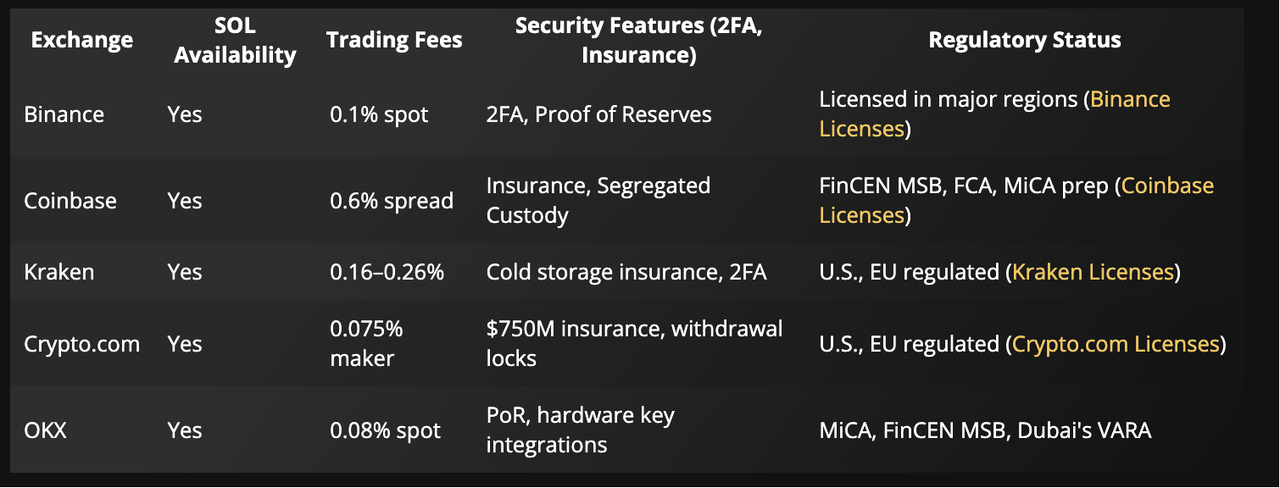
Binance: Known for global liquidity and low spot fees (around 0.1%), offering SOL trading pairs with various fiat currencies and stablecoins.
Coinbase: Easy fiat deposits, especially in the U.S., but the retail price spread is higher (around 0.6%). The advantage is strong regulatory compliance.
Kraken: Competitive maker/taker fee range (0.16-0.26%) and one of the longest regulatory records in the U.S. and EU.
Crypto.com: Global coverage, offering 0.075% maker rebates and supporting Visa cards. Particularly attractive to retail investors.
OKX: Low trading fees (~0.08%), a strong derivatives market, and integration with Web3 wallets, appealing to active traders.
Wallets and Security
Buying SOL is just the beginning. Custody strategies determine how much control investors retain and how well their assets are protected.
Hardware wallets (Ledger, Trezor): Best suited for long-term holders. They provide offline storage, protection against hacking, and allow staking through integrated applications.
Non-custodial hot wallets (Phantom, Solflare): Convenient for daily interactions with DeFi and NFTs. They require strict seed phrase security mechanisms, device-level security measures, and phishing prevention.
Custodial wallets (exchanges): Easiest to manage, but assets face trading risks. Suitable only for short-term liquidity or trading balances.
Best practice should be to split assets between hardware wallets (for long-term storage) and non-custodial hot wallets (for active users in DeFi/NFT). Always enable two-factor authentication, whitelisting, and trusted device features.
Staking Setup
Staking SOL is both a source of income and a way to secure the network. Investors must choose between native staking protocols and liquid staking protocols.
Native Staking Steps
Set up a compatible wallet, such as Phantom, Solflare, or Ledger.
Choose a validator from dashboards like Solana Beach or StakeView. Avoid selecting validators with high commissions (>10%) or poor uptime.
Delegate SOL directly. Rewards accumulate automatically every cycle (approximately every 2 days).
Use Solscan or validator tools to track staking performance.
If un-staking, be aware of a cooling-off period of 2-3 days before token circulation.
Liquid Staking Options
Protocols like Marinade and Jito allow you to hold tradable derivative tokens (mSOL, JitoSOL) while staking. This provides flexibility for DeFi but also introduces additional smart contract and liquidity risks.
In terms of security:
Staking can be done through trusted wallets or hardware devices.
Achieve delegation diversification across multiple validators to reduce slashing and centralization risks.
Confirm validator commission rates and uptime history.
Bookmark official validator dashboards and avoid links from unverified sources.
Finally, for liquid staking, verify audit history, TVL strength, and whether the protocol maintains insurance or slashing coverage.
免责声明:本文章仅代表作者个人观点,不代表本平台的立场和观点。本文章仅供信息分享,不构成对任何人的任何投资建议。用户与作者之间的任何争议,与本平台无关。如网页中刊载的文章或图片涉及侵权,请提供相关的权利证明和身份证明发送邮件到support@aicoin.com,本平台相关工作人员将会进行核查。




